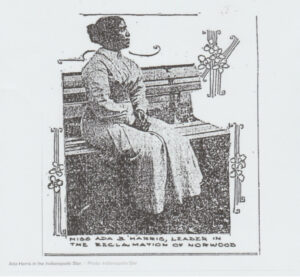The History of Giving Circles in Black America
By Dannie Gore
|
At the turn of the century, Midwestern urban Black women began taking a more active role in providing assistance to people in need.
|
|
Impersonal corporate forms of philanthropy promoted by wealthy whites, such as the General Education Board or the Rosenwald Fund, did not connect directly to community needs. Black philanthropy and charitable giving assumed the form of small-scale, personal assistance and involvement. In most cases, the women knew well the individual families or groups whom they assisted. They emphasized the importance of volunteer service and preferable to simply making financial donations to worthy causes. The goal was social change and individual improvement, not social control. Black women were central to the ideas we now call “Giving Circles” and “Responsive Philanthropy.”
|
|
The life and work of educator Ada Harris of Indianapolis, Indiana, illustrates this innovation. A 1909 Indianapolis Star article heralded Harris as the leader of the reclamation of Norwood, a small, impoverished, all-Black settlement beset with crime. Harris moved into the community after teaching in the area since the late 1880s. By 1908, she was a resident of Norwood and principal of the local school. Her greatest ambition: “I want to see my people succeed. I want them to have an equal chance.”
|
|
Harris tapped into the time, treasure, and talents of her community. She launched a drive to raise funds for the development of a Boys’ Club so adults could “teach right living in addition to the 3R’s.” The initial fund-raising campaign for the establishment of a Boys’ Gymnasium and Clubhouse netted only $35.00, which she used as a down payment on property valued at $15,000. She insisted that a gymnasium would allow the young boys to master important work skills and develop appropriate habits, focusing on athleticism and health.
|
|
Harris may also have reflected her concern with the ill-treatment and low status of Black women in Norwood. Protecting Black women also depended upon efforts to provide creative outlets for Black boys.
|
|
Such were the driving motivations of many black women who engaged in social service and reform work during the opening decades of the twentieth century. In assessing her life work, Harris declared, “my field has been small in Norwood, but it has been plenty large enough for my abilities. At least I shall have spent my life for my race.” |
3 Comments

© Copyright 2022 - The New 3Rs | Privacy Policy | Terms of Use

The Communal and Giving spirit of enslaved Afrikans was the foundation of the collective giving taking place today!!!
Harambee! Harambee! Harambee! Harambee! Harambee! Harambee!Harambee!!!
Thanks for sharing!!!